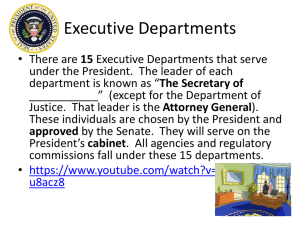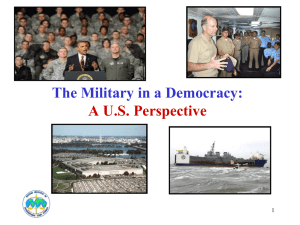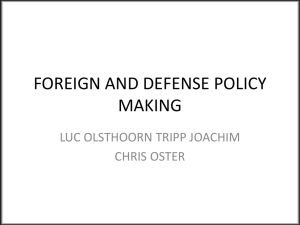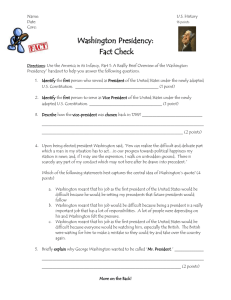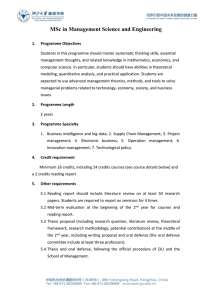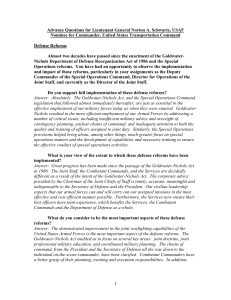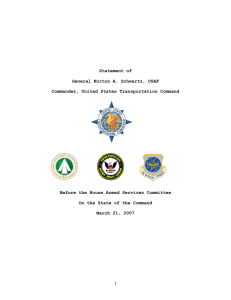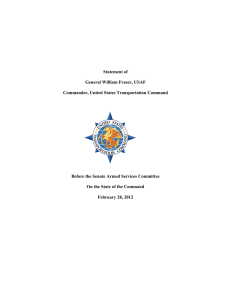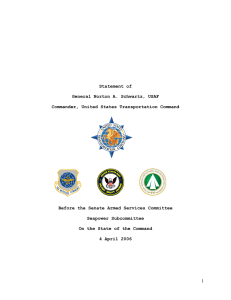ADVANCE POLICY QUESTIONS GENERAL JOHN W. HANDY, USAF
advertisement
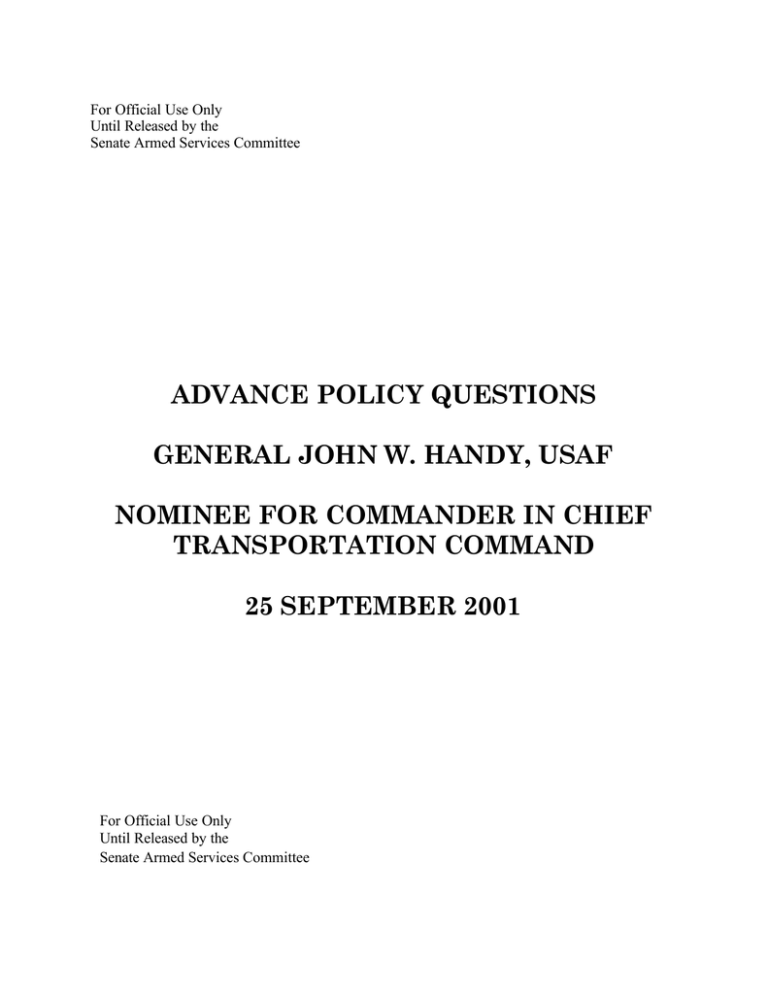
For Official Use Only Until Released by the Senate Armed Services Committee ADVANCE POLICY QUESTIONS GENERAL JOHN W. HANDY, USAF NOMINEE FOR COMMANDER IN CHIEF TRANSPORTATION COMMAND 25 SEPTEMBER 2001 For Official Use Only Until Released by the Senate Armed Services Committee Advance Confirmation Hearing Questions for General John W. Handy Nominee for the Position of Commander in Chief, U.S. Transportation Command Defense Reforms Almost 15 years have passed since the enactment of the Goldwater-Nichols Department of Defense Reorganization Act of 1986 and the Special Operations reforms. Do you support full implementation of these defense reforms? ANSWER: Absolutely. The Goldwater-Nichols Act was a much needed and very timely piece of transition legislation for our military. The issues articulated in the Act were real. Pre Goldwater-Nichols, insufficient JCS review, oversight of contingency planning, unclear chains of command, and inadequate attention to both the quality and training of officers assigned to joint duty hampered the efficient employment of our Armed Forces. What is your view of the extent to which these defense reforms have been implemented? ANSWER: Since 1986, the Joint Staff, the Unified Commands, and the Services have vigorously pursued the intent of the Goldwater-Nichols Act. Today, the corporate advice provided by the Chairman of the Joint Chiefs of Staff is detailed, meaningful, timely, and extremely influential. Our civilian leadership trusts that our armed forces can and will carry out our assigned missions in the most effective and cost efficient manner possible. The strategic planning, contingency planning, theater engagement planning, crisis response activities, programs and budgets of the Unified Commands and the services are in sync with the National Security Strategy and are based upon realistic combat and support force projections. Lastly, there has been an exponential leap in the quality and education of the personnel assigned to the various joint staffs. The Services now realize that joint experience is an absolute necessity in the career progression of its best and brightest officers and are resolutely filling their joint billet allocations with the same. What do you consider to be the most important aspects of these defense reforms? ANSWER: The most important aspect of these defense reforms has been the demonstrated improvement in the joint warfighting capabilities of the United States Armed Forces. Over the past fifteen years, the Goldwater-Nichols Act has given us a focus on joint doctrine, joint professional military education, and coordinated military planning. Chains of command have been clarified from the National Command Authority all the way down to individual on-scene commanders. Today, Combatant Commanders 2 clearly understand their planning, training and execution responsibilities. Equally important, they understand that their ability to articulate their equipment resource needs and priorities weighs heavily in the services’ POM inputs and the overall Department of Defense fiscal planning effort. The goals of the Congress in enacting these defense reforms, as reflected in section 3 of the Goldwater-Nichols Department of Defense Reorganization Act, can be summarized as strengthening civilian control; improving military advice; placing clear responsibility on the combatant commanders for the accomplishment of their missions; ensuring the authority of the combatant commanders is commensurate with their responsibility; increasing attention to the formulation of strategy and to contingency planning; providing for more efficient use of defense resources; and enhancing the effectiveness of military operations and improving the management and administration of the Department of Defense. Do you agree with these goals? ANSWER: Yes. Do you foresee the need for additional modifications of Goldwater-Nichols in light of the changing environment and possible revisions to the national security strategy? If so, what areas do you believe it would be appropriate to address in these modifications? ANSWER: The military now has 15 years experience operating under GoldwaterNichols—it’s significantly changed the way the Department of Defense operates. By and large, the changes have enhanced the way our nation employs its military forces. There may be some areas that could benefit from legislative changes; however, I would like to reserve judgment on this until after I’ve studied any specific proposals. If confirmed, I would be pleased to share my thoughts with the Committee as appropriate. Based upon your experience as Vice Chief of Staff for the Air Force, do you believe that the role of the combatant commanders under the Goldwater-Nichols legislation is appropriate and that the policies and procedures in existence allow that role to be fulfilled? ANSWER: Based upon my experience as Vice Chief of Staff of the Air Force, the role of the combatant commanders under the Goldwater-Nichols Act seems appropriate to me. Existing policies and procedures appear to allow that role to be fulfilled. If confirmed, I’ll carefully monitor my roles and responsibilities under Goldwater-Nichols and share any future observations with the Committee as appropriate. Duties What is your understanding of the duties and functions of the Commander in Chief, U.S. Transportation Command? 3 ANSWER: The mission of the Commander in Chief, United States Transportation Command is to provide air, land, and sea transportation for the Department of Defense (DoD), both in time of peace and time of war. To accomplish this mission, for day-to-day execution, the Commander in Chief, U.S. Transportation Command relies on U.S. Transportation Command’s Component Commands: the Air Force’s Air Mobility Command (AMC); the Navy’s Military Sealift Command (MSC); and the Army's Military Traffic Management Command (MTMC). To accomplish this mission requires leadership of a blend of active and reserve forces, civilian employees, and partnership with commercial industry to provide mobility forces and assets in a force structure continuum designed to make a seamless transition from peace to war. That said, the number one mission of the Commander in Chief, United States Transportation Command is to provide strategic mobility support to the regional CINCs during crises. Simply put, the U.S. Transportation Command wartime mission has three objectives: 1. Get the warfighter to the fight. 2. Sustain the warfighter during the fight. 3. Bring the warfighter home after the fight is done. What background and experience do you possess that you believe qualifies you to perform these d uties? ANSWER: Since my commissioning as an Air Force officer in 1967, I have been blessed with a host of opportunities and experiences…as well as with some of the finest commanders, bosses, teachers, mentors, role models and friends that the Services have ever produced. From July 1997 to October 1998, I commanded half of AMC’s airlift and tanker aircraft, supporting global mobility operations worldwide. Prior to that assignment I had served two years as the commander of Headquarters Military Airlift Command’s Airlift Control Center and later as commander, Headquarters Air Mobility Command’s Tanker Airlift Control Center. This assignment was followed by almost two years as the U.S. Transportation Command director of operations and logistics. Additionally, I have twice served as a wing commander for an airlift wing, and as director of programs and evaluations and deputy chief of staff for installations and logistics at Headquarters U.S. Air Force. As the Vice Chief of Staff of the Air Force, I had direct, personal and frequent contact with the SECDEF, CJCS, all the CINCs and the Service Chiefs on many major issues, operations, and planning matters confronting all the CINCs, including USCINCTRANS. Throughout these past 34 years I have watched our military grow and evolve into a force that today is recognized as the best equipped, trained, and educated in the world…perhaps the finest team of military professionals the world has ever known. If confirmed, I will be honored to lead one of 4 the most critical components of that team. I am a true believer in the Total Force Concept that leverages active, guard, and reserve component forces of all services to meet our national security challenge. The command experiences, field training and education I’ve been fortunate to have thus far have prepared me for the tasks ahead. I look forward to the opportunity to serve our country and the great men and women of the United States Transportation Command. What are the most important lessons that you have learned as the Vice Chief of Staff for the Air Force? ANSWER: In my role as Vice Chief of Staff of the Air Force, I’ve learned the true value and critical importance of building a cohesive team—not only within the Air Force, but also with the other Services and organizations within the interagency process, as well as the many civilian communities that support our nation’s military. If confirmed, I will continue to nurture and build the great team at U.S. Transportation Command, ensuring our nation continues to have trained and ready mobility capabilities to support the nation’s interests anytime, anywhere. Do you believe that there are actions you need to take to enhance your ability to perform the duties of the Commander in Chief, U.S. Transportation Command? ANSWER: A complete understanding of current Defense Department and national transportation issues is essential to my ability to discharge these important duties. If confirmed, I will do everything within my power to insure I remain ready for this critical duty. Assuming you are confirmed, what duties and functions do you expect that the Secretary of Defense and the Chairman of the Joint Chiefs of Staff would prescribe for you? ANSWER: I would anticipate the Secretary and the Chairman to direct me to prepare U.S. Transportation Command to meet the supported CINC requirements for any contingency. I also believe they would direct me to provide the most effective and efficient transportation services available in peace or war. All the normal duties and functions of command would be directed toward those ends. That said, I stand ready to follow any duties or functions assigned. Relationships Please describe your understanding of the relationship of the Commander in Chief, U.S. Transportation Command to the following officials: 1. The Secretary of Defense. 5 ANSWER: An objective of the Goldwater-Nichols Act of 1986 was to clarify the command line to combatant commanders and to preserve civilian control of the military. That act stated that the operational chain of command runs from the President to the Secretary of Defense to the combatant commanders. As such, the Commander in Chief, U.S. Transportation Command is directly responsible to the National Command Authorities, President and Secretary of Defense, for the performance of the defense transportation mission and the preparedness of the command. 2. The Deputy Secretary of Defense. ANSWER: The Deputy Secretary of Defense is delegated full power and authority to act for the Secretary of Defense and exercise the powers of the Secretary on any and all matters for which the Secretary is authorized to act according to law. As such, the Commander in Chief, U.S. Transportation Command will normally report through the Secretary, but will report to and through the Deputy Secretary the same as he would the Secretary when the Deputy Secretary is representing the Secretary. 3. The Under Secretaries of Defense. ANSWER: Under current DoD Directives, Under Secretaries of Defense coordinate and exchange information with DoD components, including combatant commands, having collateral or related functions. In process and in practice, this coordination and exchange is normally communicated through the Chairman of the Joint Chiefs of Staff. If confirmed as a combatant commander, I will respond and reciprocate accordingly. 4. The Assistant Secretaries of Defense. ANSWER: With the exception of the Assistant Secretaries of Defense for C3I, Public Affairs and Legislative Affairs, all Assistant Secretaries are subordinate to one of the Under Secretaries of Defense. This means that any relationship U.S. Transportation Command would require with any Assistant Secretary of Defense would be through the Under Secretary of Defense for Policy, the Under Secretary for Personnel and Readiness, or the Under Secretary of Defense for Acquisition and Technology. Since the Assistant Secretaries of Defense for C3I, Public Affairs and Legislative Affairs are SECDEF’s principal deputies for overall supervision of C3I, Public Affairs and Legislative matters respectively, any rela tions required between U.S. Transportation Command and ASD(C3I) and ASD(LA) would be conducted along the same lines as those discussed above regarding relations with the various Under Secretaries of Defense. 5. The Chairman of the Joint Chiefs of Staff. ANSWER: The Chairman is clearly established by Title 10 as the principal military advisor to the National Command Authorities (NCA). However, he serves as an advisor and is not, according to the law, in the chain of command that runs from the NCA directly to each combatant commander. The law does allow the President to direct that communications between him or the Secretary of Defense and the combatant 6 commanders be transmitted through the Chairman and former President Clinton directed this to happen though the Unified Command Plan. This action keeps the Chairman fully involved so that he can execute his other legal responsibilities. Certainly a key responsibility is his role as spokesman for the CINCs, especially on the operational requirements of their respective commands. While the legal duties of the Chairman are many and they require either his representation or personal participation in a wide range of issues, if confirmed as a CINC, I will have an obligation to keep both the Chairman and the Secretary of Defense promptly informed on matters for which they may hold me personally accountable. 6. The Secretaries of the Military Departments. ANSWER: The Secretaries of Military Departments are responsible under Title 10, for the administration and support of the forces they have assigned to combatant commands. The authority exercised by a combatant commander over Service components assigned to his command is quite clear, but requires a close coordination with each Secretary to ensure there is no infringement upon those lawful responsibilities a Service Secretary alone may discharge. 7. The Chiefs of Staff of the Services. ANSWER: The Chiefs of Staff of the Services have two significant roles. First and foremost, they are responsible for the organization, training, and equipping of their respective Service. Without the full support and cooperation of the Service Chiefs, no CINC can hope to ensure the preparedness of his assigned forces for whatever missions the NCA directs. Next, as members of the Joint Chiefs of Staff, the Service Chiefs have a lawful obligation to provide military advice. Individually and collectively, the Joint Chiefs are a source of experience and judgment that every CINC can call upon. If confirmed as Commander in Chief, U.S. Transportation Command, I intend to pursue a full and continuing dialogue with the Chiefs of all four Services, as well as with the Commandant of the US Coast Guard. 8. The Combatant Commanders. ANSWER: If confirmed, my relationship with the other combatant commanders will be one of mutual support, continued dialogue on key issues, and frequent face-to-face interaction. In today's security environment, an atmosphere of teamwork and complete trust is critical to the successful execution of U.S. national policy. Major Challenges and Problems In your view, what are the major challenges that will confront the Commander in Chief, U.S. Transportation Command? Assuming you are confirmed, what plans do you have for addressing these challenges? ANSWER: In my view, in order to provide world-class support for the warfighting CINCs as well as meet the DoD’s peacetime transportation needs, we must have robust 7 capability and readiness--now and in the future. While our current national military strategy demands we be able to provide strategic deployment and sustainment support for two near simultaneous major theater wars, we must also prepare ourselves for the future. The United States Transportation Command team plays a critical role in fulfilling the four operational concepts espoused in the Chairman’s Joint Vision 2020: dominant maneuver, precision engagement, full dimensional protection, and focused logistics. The challenges I see on the horizon for the Defense Transportation System (DTS) are: PEOPLE: There are no more precious resources in the DTS than our people. Our soldiers, sailors, marines and airmen must enjoy a quality of life that allows them to focus on their military tasks without distraction. We are obliged to keep faith with these self sacrificing individuals and families by providing an adequate standard of living, quality medical care, inflation adjusted retirement benefits, quality household goods moving services, respectable housing accommodations, and caring family support programs. I salute our Congress for its continued support in all these areas and I ask for your continued assistance in championing initiatives that reassure our troops that they are indeed our number one priority. READINESS: While overall military end strength numbers continue to drop, the requirements and demands of today’s contemporary international security environment remain very high. The pace of activity in the DTS in the post DESERT SHIELD/DESERT STORM era, in support of mobility operations worldwide, continues at an almost wartime level of effort. We must curb the impacts of this high OPTEMPO by improving our efficiency and carefully monitoring the day-to-day demands and requirements placed on the DTS. Specifically, ensuring the command remains ready will require continued focus on the readiness of air mobility, sealift, forward presence, partnerships with industry, and Antiterrorism and Force Protection (AT/FP). MODERNIZATION: U.S. Transportation Command’s modernization efforts are focused on being able to fully meet America’s strategic mobility requirements, across the spectrum of operations, while simultaneously reducing risk, ensuring future readiness, and providing a framework for meeting future MRS-05 requirements. Continued acquisition of the C-17, upgrade of our C-5 and KC-135 fleets, standardization and modernization of our C-130 fleet, completion of existing sealift programs, improvements to the network of bases which comprise our global transportation infrastructure, and upgrades to the tremendous capability enhancers inherent in our transportation information systems capability, are all key pillars of this comprehensive modernization program. Additionally, the command is looking well ahead to identify, develop, and program projects for the inevitable future recapitalization of aging air mobility and sealift systems, as well as our global transportation infrastructure. PROCESS IMPROVEMENTS: U.S. Transportation Command processes, the collection of rules and procedures which govern day-to-day business practices, are under constant revision as the command seeks to improve the speed and reliability of 8 customer service. The goal is a set of “most effective and efficient” processes that are applicable across the entire spectrum of our activities, from interaction with our commercial transportation providers to our “warfighter CINC” customers. Whether the issue is information technology, supply-chain management, doctrine or training, U.S. Transportation Command is constantly searching for the best business practices available today. These efforts must be continued to ensure the future viability of the DTS. What do you consider to be the most serious problems in the performance of the functions of the Commander in Chief, U.S. Transportation Command? If confirmed, what management actions and time lines would you establish to address these problems? ANSWER: The most serious problem facing us in the mobility business is the daily challenge of meeting the readiness needs of our theater CINCs. While we have done a superb job of meeting these needs on a daily basis over the years since Desert Shield and Desert Storm, our capability to continue meeting this challenge, at the levels we are sustaining, is very fragile. We must be ever vigilant in our struggle to keep our forces the best organized, trained, and equipped in the world. The challenges are many: maintenance of an adequate quality of life, modernization of our equipment and facilities, and controlling an escalating OPTEMPO in the face of level funding and personnel fielding. I believe we can meet these challenges, and if confirmed, I look forward to working with the members of this Committee to do just that. As far as a time line goes, I can only say that I see this as a continuing challenge which, with your approval, I will formally pick up—-with enthusiasm--on day one. Priorities If confirmed, what broad priorities will you establish in terms of issues which must be addressed by the Commander in Chief, U.S. Transportation Command? ANSWER: Like my predecessor, I believe U.S. Transportation Command’s approach to posturing (and improving) itself to be able to meet DoD’s transportation mission today and tomorrow requires flexibility and initiative, and must be guided by the following four basic themes: ?? Theme one: Maintaining readiness to perform our global mobility mission. ?? Theme two: Continuing modernization and upgrade of aging equipment and infrastructure. ?? Theme three: Improving key processes in the DTS. 9 ?? Theme four: Investing in the care and quality of U.S. Transportation Command’s most valuable resource -- its people. Lift Requirements One of the principal shortfalls faced by the United States military is the ability of our lift assets to support two major theater wars. While we have made great efforts to eliminate the deficiency in lift assets, this shortfall continues to emerge as one of the greatest threats to our ability to successfully execute the national military strategy. If confirmed, what actions will you take to ensure that we have sufficient lift assets to support the combat forces’ execution of the national military strategy? ANSWER: USTRANSCOM is sized as a 1 MTW mobility force. As long as the command executes current programs, sealift is in acceptable condition, although there is a need for specialty ships such as heavy lift sealift. Airlift is the most pressing challenge. As MRS-05 validated, an increase is needed to the capability of our airlift fleet (54.5 MTMs) through additional C-17s and modernization of our C-5s. Initial review of the new strategy, coupled with Service transformation efforts, leads to conclusions that strategic mobility will be more demanding not less. Therefore, the MRS-05 conclusions are the minimum improvements needed. As USCINCTRANS, I will continue advocating for additional C-17s and a robust C-5 RERP program. I will also continue to pursue the possibility of commercial BC-17s augmenting our organic fleet. The time is now to make a commitment to a new 60 aircraft Multi-Year Procurement (MYP) in order to get these additional C-17s at the best possible price. Threat Do you believe that projected changes in the threat and in overseas bases should affect the mix of U.S. Transportation Command’s strategic mobility triad of prepositioned ships, airlift, and sealift? If so, how should the current mix be changed? ANSWER: Although the Mobility Requirements Study 2005 (MRS-05) assumed accomplishment of all overseas infrastructure projects that are currently programmed, air and sea port availability and capability still remain a concern. Past and present demands have strained the overseas air mobility infrastructure facilities and raised questions about their sufficiency to meet the National Military Strategy. USTRANSCOM has focused its most important current infrastructure efforts on recapitalization of runways, ramps, and fuel systems at en route airfields. In keeping with the findings of USTRANSCOM’s En Route Studies, the command has worked with USEUCOM, 10 USPACOM, and DLA to develop recapitalization plans. For example, DLA has allocated approximately 85% of its fuels MILCON FY 99-04 POM to en route projects. September 11th drove home to all Americans that we face a changing threat. Be assured that USTRANSCOM is ready to respond to the call to deploy forces in response to those atrocities. To that end, I’m confident that the command’s prepositioned ships, airlift, and sealift assets are properly configured and prepared to support Operations NOBLE EAGLE and INFINITE JUSTICE. USTRANSCOM continues efforts to counter the threat from weapons of mass destruction, such as chemical and biological weapons, at our aerial and seaports. Such weapons can severely hinder strategic mobility industrial infrastructure and particularly threaten the civilian partners in the CRAF and VISA programs. Consequently, USTRANSCOM has become one of DOD’s strongest proponents for improved detection, protection, and decontamination capability. The command is actively engaged in several joint projects intended to address the WMD threat, including the development of national standards for decontamination. Additionally, USTRANSCOM’s Critical Infrastructure Protection (CIP) program is underway, stemming from Presidential Decision Directive 63. The CIP program, in coordination with other DOD agencies, Joint Staff, Services, geographic CINCs, and Department of Transportation (including MARAD and U.S. Coast Guard), is actively identifying assets critical to the Defense Transportation System (which includes those assets of our commercial partners). Vulnerability assessments will then be conducted at critical transportation locations, with necessary follow-on actions taken to ensure that those critical assets are protected. Port and Airfield Availability In your opinion, are sufficient port and airfield on-load and off-load assets available in CONUS and in the most likely conflict areas to rapidly move the equipment and supplies that might be required over the full spectrum of conflict? If not, what steps do you believe should be taken to improve this situation? In your opinion, are the conditions of these facilities adequate to support the strategic deployments of our forces? What is the condition of the enroute system and their ability to refuel and support the airlift mission? ANSWER: Assessments of the sufficiency of CONUS and overseas ports and airfields to support strategic mobility are highly "scenario dependent." Overseas, whether mobility supports a small-scale contingency (SSC) or a major theater war (MTW), our forces require access to host nation ports and airfields. In some cases, particularly for the air mobility en route system, our forces require friendly nation airfield resources at locations that may or may not be directly involved in the contingency. For example, any US response in Southwest Asia will require air mobility en route basing in Europe and will usually require access to peripheral Gulf State airfields as well; any US response in the Pacific Rim becomes problematic without Mainland Japan and Okinawa support. If 11 the SSC occurs in areas accessible from our established Airlift En Route Systems, our ability to respond effectively is reasonably assured with host nation concurrence. If the SSC occurs in areas not in line with our Airlift En Route System, response time would be difficult (Africa, South America, areas of Southeast Asia). USTRANSCOM should continue to work with the geographic CINCs to ensure the Strategic Mobility requirements for overseas ports and airfields are met in planning for the total range of conflict. The En Route System is aging but it is currently funded for upgrades to meet the future demands that are outlined in MRS-05. USTRANSCOM should also continue to support the Army and Navy in the development of a Joint Logistics Over-the-Shore capability for those scenarios where fixed port facilities are degraded or denied by enemy forces. In CONUS, if the Services fund the MRS 05 shortfalls identified, (to include depot shortfalls), I believe throughput constraints and availability of ports and airfields for the most demanding Major War requirements will be addressed. The Army Power Projection Program should improve key installations, ammunition depots and ports. This program provides for rail, airfield, and staging area improvements, completion of key projects at the West Coast containerized ammunition port (Concord), and other installation-specific projects. Acceleration of many of these projects is needed. Interfaces between the Services must be improved for power projection of one service from another service’s installation. Funding of Container Handling Equipment (CHE) is also necessary for movement of containerized cargo at installations and ammunition depots. Also, the National Port Readiness Council is functioning and working closely in planning with DOT and the nation’s commercial port industry to ens ure wartime requirements can be met in order to minimize our permanent presence at commercial ports. The present inventory of aircraft loaders, called Material Handling Equipment (MHE), used at aerial ports for onloading and offloading US military and Civil Reserve Airlift Fleet aircraft is still very old and unreliable. That said, I believe the new Air Force 60K loader and Next Generation Small Loader (NGSL) programs will provide the equipment needed to meet future MHE requirements. An additional piece of critical equipment is the 463L All-Terrain 10 K forklift. Their numbers are high, and they too require an aggressive replacement program. This piece of equipment is critical to deployed operations in rough or unimproved environments. We continue to work closely with geographic CINCs on Host Nation Support issues to support onward movement of equipment and supplies from theater ports to the final destination. Tanker Crews During the Kosovo operation, we found that we had sufficient tanker assets available to support the air campaign, but that, at times, there were limitations in having 12 sufficient crews available for these tankers to support operations due to a number of considerations, including crew rest requirements. What steps do you intend to take to ensure that there will be sufficient tanker crews available to support air campaigns in future conflicts? ANSWER: USTRANSCOM and AMC recognize that the KC-135 crew ratio of 1.36 for the AMC force and 1.27 for all others was based on a cold war scenario and is not adequate for today's increased mission demands. This was proven during the Gulf War when we operated with a 1.5 crew ratio and again in Kosovo when we operated at a 1.8 crew ratio. Only the limited nature of these conflicts kept us from experiencing shortages in crews. To further quantify the requirement for tankers and crews AMC conducted a thorough Tanker Requirements Study. In an attempt to rectify the shortfall in crews and maintenance identified by these events and study, a FY02 POM initiative was submitted for additional maintenance personnel and for 75 additional aircrews. Unfortunately, the positions were either not funded or were only approved without an increase in overall military end -strength. We have continued to voice our concern by raising the issue through the Joint Requirements Oversight Council and the Joint Warfighting Capabilities Assessment. As USCINCTRANS, I will continue to advocate for additional KC-135 maintenance personnel and a crew ratio increase. As we all work through the details of the new strategy laid out in the QDR and DPG, we will determine if tanker crew ratio will need to be increased even more. I realize the competition for scarce dollars will always be keen and I, along with all national leaders, will be forced to choose between myriad critical programs. That being said, my goal will be full funding of additional tanker personnel, to include the commensurate endstrength increase. Ready Reserve Force U.S. military strategy depends on having sufficient civilian merchant mariners available in a conflict to operate the ships in the Ready Reserve Force (RRF). There are continuing concerns that the combination of the reduction in numbers of U.S.-flag merchant ships and the smaller sizes of crews on these ships could leave the United States with an inadequate pool of trained manpower upon which to draw in wartime. 13 Do you believe that this is a real problem? ANSWER: Yes. However, it is a problem that USTRANSCOM is aware of and is actively working with the Maritime Administration, the U.S. Coast Guard, the sealift industry, maritime unions, and DoD. The decline in the number of U.S. Flag ships has definite consequences for our national security capabilities. Today, we can meet manning requirements for the Ready Reserve Fleet. We will continue to support ongoing efforts to ensure our manning capability for the future. The assignment of partial crews to the highest priority vessels (ROS-4, ROS-5) has improved the manning of RRF vessels, as well as the material readiness of the fleet. Now, two thirds of the ships in the RRF are partially crewed. I also support the Maritime Security Program which I view as essential to maintaining a nucleus of U.S. flag ships that will continue to employ American crews. Other programs such as the Jones Act (domestic trade) and cargo preference help keep ships under the U.S. flag (with American crews) and are key to maintaining the pool of highly trained mariners. What steps would you propose to take to solve any shortages that you might identify in manning the RRF? ANSWER: I will continue to foster the strong partnership USTRANSCOM has with the U.S. maritime industry and using this partnership as a spring board to keep moving this difficult mariner issue forward. As recently as last week, USTRANSCOM held a Video Teleconference with VISA carriers to discuss current events (Noble Eagle, Infinite Justice) and exchange ideas about supporting potential future operations. We continue 14 to work the mariner issue hard with MARAD, the U.S. Coast Guard, the carriers and the maritime unions. A key issue is identifying active merchant mariners and licensed/certified mariners that are no longer sailing; the goal is a consolidated database identifying available and qualified mariners to crew organic sealift. We also encourage all licensed and documented mariners to maintain their licenses and/or documentation. This partnership is healthy and is an absolute necessity in these uncertain times. Prepositioned Ships If confirmed, what actions would you take to ensure U.S. Transportation Command’s support of the Army and Marine Corps strategies for afloat prepositioned ships? ANSWER: In my view, the use of equipment and supplies strategically positioned afloat near potential hot spots is a critical component of the new strategy that requires the elements of speed and flexibility. The services must continue to identify their specific prepositioning requirements including special purpose shipping (Float-on/Float-off, Heavy Lift), and we must ensure we have the proper mechanisms (e.g., acquisition, contracting) to provide the right types of vessels and crews, that enable them to meet their mission. In view of recent events, we will place more emphasis on the force protection aspects of this relationship. C-5 Modernization Over the past severa1 months, significant problems have arisen with the readiness of the C-5 aircraft. These problems have reduced the availability of this airframe which has a direct impact upon the ability of our strategic airlift assets to support the national military strategy. The Air Force has been pursuing a two-pronged approach of upgrading avionics for all C-5s, while, for the time being, only re-engining the newer C-5B aircraft. General Robertson testified to the Committee earlier this year that he believed that we needed to 15 upgrade and re-engine all C-5 aircraft, and buy more C-17s in order to meet the lift requirements USTRANSCOM faces. What is your assessment of the requirements for additional airlift, and the programs needed to meet those requirements? ANSWER: I wholeheartedly agree with Gen Robertson’s assessment. MRS-05 clearly validated 54.5 MTM/D as the absolute minimum strategic airlift requirement. As you know, that is an increase of almost 5 MTM/D from the MRS-BURU requirement and an increase of 10 MTM/D over what AMC is actually capable of today, recognizing that current capability is reduced due to poor C-5 reliability. This leads to that two-pronged approach that is so vital to meeting critical airlift needs. The C-17 and C-5 are essentially the only two airlifters capable of carrying oversize and outsize cargo. First let me discuss the C-5. As I mentioned earlier and the committee is very much aware, we have been experiencing serious degradation in the C-5 mission capable (MC) rate. The Air Force has been pursuing the C-5 Reliability Enhancement and ReEngining Program (RERP) to increase the C-5 MC rate from below 60% to at least 75%. Due to the affordability of C-5 RERP, coupled with the extensive structural service life remaining on the airframe, we feel strongly about pursuing the RERP program. The best way to approach the C-5 RERP program is to RERP the C-5Bs first and then tackle the C-5As. The 50 C-5Bs are only 12 years old, they are the ones that are equipped with air defensive systems, and they fly the most on a day-to-day basis. Once we see the success of the RERP program on the C-5Bs, then we can make a decision on modifying the 76 thirty-five-year old C-5As. The second thing we absolutely must do to meet the 54.5 MTM/D minimum requirement is purchase additional C-17s. While some may wonder if the commercial sector can provide part of the 5 MTM/D increase via the CRAF program, that is not possible. This is an over and outsized requirement that can only be met by organic airlift; that leads us to additional C-17s being the practical choice. Our analysis tells us that we need an additional 50-60 organic C-17s, depending on what decisions we make on the C-5 RERP. The most bang for the buck is a 60 aircraft multi-year procurement (MYP) and the time to strike on making a firm commitment to this new MYP is now. Boeing’s supply line will begin to close 1 Oct 2001 without a follow-on decision by DoD. If we delay beyond 1 Oct, our cost per aircraft will grow significantly due to the need to restart subcontractor production lines that are scheduled to shut down soon. Additionally, if the commercial sector finds there is a niche market for the BC-17, we expect that small fleet will augment our organic fleet. In summary, an integrated solution that fixes the C-5 and acquires additional C-17s via a new MYP is essential to meeting the nation’s strategic airlift needs. Movement of Household Goods 16 The Committee is aware that the Department has launched a Full Service Moving Project (FSMP) test program for handling the transportation of household goods for permanent changes of station. Do you believe there is sufficient funding in the budget request to implement this program? ANSWER: No. Due to funding constraints the Military Services unanimously have decided to cease participation in the Full Service Moving Project (FSMP) effective September 30, 2001. Initial estimates are the program could be as much as 70-80% higher than the current program. Historically, DoD has spent approximately $1.7B annually on the current program. When will the Department have sufficient information upon which to base a decision about whether to seek wider implementation of this program? ANSWER: USTRANSCOM is tasked with the independent evaluation of three pilot programs (the FSMP pilot, the Navy Sailor Arranged Move (SAM) pilot and the Military Traffic Management Command (MTMC) pilot). Data collection is complete for the MTMC and SAM pilots, FSMP is ongoing. The Military Services agreed to continue participation in the pilot through the peak season (Jun-Jul 01) pick-ups and deliveries. After data collection and analysis is complete (Dec 01), USTRANSCOM will provide a recommendation to the Office of the Secretary of Defense for a new personal property program, which could be adoption of one of the pilots, but most likely will be a combination of features from each. Our recommendation is scheduled to be complete Jan 02. In your opinion, how does this program compare to the other pilot programs for improving the movement of household goods? ANSWER: We have not had a chance to collect and analyze sufficient data to draw any conclusions on the FSMP pilot program at this time. We expect to complete our recommendation in Jan 02. Selection of Officers for Assignment as Commander in Chief, U.S. Transportation Command In S. 1416, the Committee included a provision that, if enacted, would express the sense of the Congress that when deciding on officers to be nominated to the position of Commander in Chief, U.S. Transportation Command, the Secretary of Defense shall consider nominating highly qualified officers from the ranks of the Army and Marine Corps. The rationale for this provision is that USTRANSCOM and its component commands could benefit from the appointment of an officer selected from 17 the two branches of the Armed Forces that are the primary users of their transportation resources. What is your view of this provision? ANSWER: The Commanders of the Unified and Specified Combatant Commands are responsible to the President and the Secretary of Defense for accomplishing the military missions assigned to them and exercise command authority over the forces assigned as directed by the Secretary of Defense. Based upon the requirement of the particular command, the Secretary of Defense should nominate the best qualified officer for command, regardless of service. In today’s joint environment all services must work together for mission accomplishment and it is imperative that each command has the most highly q ualified officers in leadership positions. Theater Access One of the principal concerns when preparing for future operational deployments is the prospect of access denial, i.e., denial of access to ports and airfields in the theater of operations. This could pose a significant challenge to USTRANSCOM's ability to support the deployment and replenishment of forces in a major theater war. What actions would you propose to better prepare the U.S. military for the prospect of fighting in a theater of operations where access to critical ports and airfields is denied? ANSWER: Access denial is already the toughest challenge we face today. Conducting reception, staging, onward movement and integration (RSO&I) of forces into a theater is tough business in countries with modern facilities, let alone when access is denied. First, USTRANSCOM will continue to work with geographic CINCs to identify alternative basing opportunities within their AORs should we be denied access to current en route basing. Working with o ur allies in peacetime to ensure access is our first line of defense. Second, USTRANSCOM must continue to develop Joint Logistics Over-the-Shore (JLOTS) capability to provide the ability to operate in degraded ports or conduct instream operations. These operations include Army and Navy lighterage, Auxiliary Crane Ships (T-ACS) from the Ready Reserve Fleet, our Offshore Petroleum Discharge Systems (OPDS), and the trained units to execute these difficult operations. Third, USTRANSCOM will work with the Navy on the Heavy Sealift Study to ensure the specialized strategic lift to move Army watercraft, Navy Mine Countermeasure vessels, and USCG patrol craft. These assets are essential for opening ports and force protection during normal or port denial operations. 18 Combating Terrorism Ensuring that the various federal response teams arrive at a domestic WMD incident in a timely fashion is of critical importance. In your view, does USTRANSCOM have sufficient lift assets to ensure appropriate DoD support in a timely fashion? ANSWER: First it is important to recognize that USTRANSCOM is sized as a 1 MTW mobility force. So under normal peacetime operations, the command will generally have sufficient lift assets to meet this mission. The challenge is when other eve nts are occurring around the world, such as major wars and small-scale contingencies (SSCs). Airlift is the most pressing challenge because of the early demands placed on the fleet during any crisis. Our initial review of the new strategy leads to the conc lusion that strategic mobility requirements will be even more demanding than MRS-05, in part due to the likelihood of a homeland defense response occurring concurrently with major wars overseas. We will have to rely on other transportation modes (rail, truck) to free up critical airlift. If confirmed, how would you ensure that DoD has sufficient lift assets to rapidly deploy its own various response units in the event of a domestic WMD event? ANSWER: Let me reiterate that I will ensure the Homeland Defense options are integrated into future plans. We do not know the requirements for this option today. Ensuring DOD has the appropriate lift assets will require close inter-Departmental planning and coordination with FEMA, FBI and other agencies that respond to such events. Mobility Requirements Study for Fiscal Year 2005 The Mobility Requirements Study for Fiscal Year 2005 (MRS-05), which was delivered to Congress this year, indicates the major weakness in strategic lift assets is in the area of strategic airlift. One of the studies that was used in the development of this finding was the Oversize-Outsize Cargo Requirements Study, which has yet to be delivered to Congress. If confirmed, will you ensure that this study is delivered to the Congress? 19 ANSWER: As General Robertson reported to the Senate Armed Services Committee, Seapower Subcommittee on 26 Apr 01, the study is done. At that time he also shared the results with you; I will be willing to do the same. As the strategic review (QDR) is wrapped up and integrated in OSD, I would then expect that the O&O AoA would be released. Since MRS-05 did not take into account the transformation efforts of the services, particularly that of the U.S. Army, nor any changes to the National Military Strategy, do you think that the identified shortfall in strategic airlift is still valid? ANSWER: MRS-05 did not include current service transformation efforts nor the impact of the emerging National Military Strategy (NMS). However, it does provide a moderate risk single MTW strategic lift capability that can cycle to a second MTW while concurrently supporting the warfighting CINC’s intra-theater requirements, NCA directed special operations missions, missile support to allies, and some support to CINCs not engaged in warfighting. Therefore, I would characterize the MRS-05 moderate risk solution (54.5 MTM/D) supported by the Chairman, Service Chiefs and CINCS as a valid building block for the future until we work out all the details of the new NMS. I should also note here that as we shift from the current threat based strategy to the new capability based construct, we are not only changing the shape of forces, but the response times are faster (Service Transformation). Additionally, the emerging strategy has new overlapping requirement for homeland defense, deterrence in four critical regions, the need to win decisively, defeat efforts in another theater, and support SSCs (non-critical areas). Bottom line, I see the mobility requirements for the new strategy as being at least as demanding as the current strategy. Congressional Oversight In order to exercise its legislative and oversight responsibilities, it is important that this Committee and other appropriate committees of the Congress are able to receive testimony, briefings, and other communications of information. 20 Do you agree, if confirmed for this high position, to appear before this Committee and other appropriate committees of the Congress? ANSWER: Yes. Our nation was founded on the principal of civilian control of the military. I am honored to have the opportunity to serve in this challenging position, and I look forward to periodically appearing before this Committee to keep you personally apprised of the readiness status and mission related requirements of the United States Transportation Command. Do you agree, when asked, to give your personal views, even if those views differ from the Administration in power? ANSWER: Yes. In 1967, I raised my right hand and swore then to "support and defend the Constitution of the United States"; my commitment to that ideal has only grown stronger over the past 34 years. I am keenly aware of the responsibility I have to provide candid, honest information to my superiors, regardless of the pressures or politics surrounding the situation. Do you agree, if confirmed, to appear before this Committee, or designated members of this Committee, and provide information, subject to appropriate and necessary security protection, with respect to your responsibilities as the Commander in Chief, U.S. Transportation Command? ANSWER: Yes. If confirmed, I look forward to appearing and testifying before this Committee at both annual posture hearings and on any other specific issues you may require. I view frequent and open interaction with this Committee and the Committee’s Staff as vital to the successful resolution of United States Transportation Command’s issues –- now and into the future. Do you agree to ensure that testimony, briefings and other communications of information are provided to this Committee and its staff and other appropriate Committees? ANSWER: Yes. If confirmed, I will ensure that this Committee and other oversight Committees are provided with required and requested information in as accurate and as timely a manner as possible.
